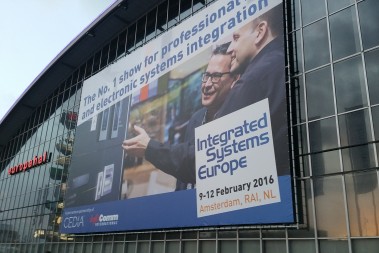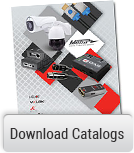ISE 2016 Show Review
Friday, March 4, 2016 8:13:03 PM America/New_York

ISE is now officially the world’s largest AV and systems integration tradeshow. We look back at some trends and highlights for the four days of ISE 2016.
When one considers how crowded some of the aisles and escalators were at the show last year, particularly on the middle day, we can be thankful for the addition of a fourth day at ISE 2016 – particularly bearing in mind the fact that attendance increased by just over 10%. This year’s total attendance was 65,686, making ISE officially the world’s largest AV and systems integration tradeshow.
While the final day – Friday – undoubtedly saw lower visitor levels than the other three days, it was always going to be something of an unknown quantity. The hope is that, as ISE MD Mike Blackman said in his interview in Installation last month, that both exhibitors and attendees become accustomed to treating the final day as a ‘proper’ show day; and initiatives on ISE’s side, such as the Friday Keynote and other events – organised under the FRDY@ISE umbrella – continue to attract visitors to the latter part of the show.
Video trends
Brighter projectors, smaller pixel pitches, higher resolutions, thinner bezels – many of the display trends at ISE 2016 were continuations of well-established themes. Just about every projector manufacturer seemed to be claiming a world first: for instance Barco with the smallest and lightest 4K laser phosphor projector; Christie with the brightest 1-DLP laser phosphor; and Epson with the first 25,000-lumen 3LCD model.
As Rob Lane mentions in his column on page 16, SiliconCore was displaying a prototype 0.95mm LED display, while Aoto had its 0.75mm M Series on display. (Turn to Rob’s column for more on display trends at ISE, particularly with reference to LED.)
Aptovision launched a new version of its BlueRiver chipset that it claimed was the first that can process 4K video at 60fps and 4:4:4 colour depth. Because many manufacturers were using chips that cannot manage this, we noticed much greater emphasis this year on the detail of exactly what flavour of 4K they could deliver.
Elsewhere, products were unveiled with new capabilities for signal transmission: Wyrestorm’s first HDBaseT 2.0 extender, can transmit 4K video a distance of 100m (or 1080p 150m) along a single Cat6 cable; and on the residential side, Metra Home Theater Group’s Ethereal Gigabit Accelerator enables 4K/60fps/4:4:4 video to be sent 15m over existing passive HDMI® cables.
While 4K was a common theme across the show, 8K made a few appearances as well. Sharp had the first European showing of an 85in display with 8K resolution, and AV Stumpfl launched an 8K version of its Wings Engine Raw media server.
Audio
While Hall 7 has unofficially been ‘the audio hall’ at ISE for a few years now, 2016 saw it gain that designation officially, as Audio became a dedicated showfloor area alongside Digital Signage, Residential Solutions, Unified Communications and Smart Building.
Audio networking was a key trend this year: the growth in the number of Dante-enabled products had risen to 700, although the growth is so rapid that Audinate’s stand graphics and even its pre-show press release contained figures that were out of date by the show. Audinate showcased its Dante Via software, which enables computers and other devices to be connected to a Dante network via USB, Firewire or Thunderbolt. Genelec, meanwhile, debuted the world’s first audio-over-IP studio monitor.
At the same time, two industry organisations were promoting technologies that make the choice of networking protocol less of a key issue. The Media Networking Association hosted a panel discussion on the effect of the AES67 interoperability standard on the industry. As Ethan Wetzell from Bosch commented: “AES67 is unifying technology that gives users freedom of choice and doesn’t lock them into systems.”
The OCA Alliance demonstrated how open control architecture – now formalised into the AES70 standard, allows different manufacturers’ products, operating with different network transport protocols, to work under a single interoperable control system.
Collaboration
We also noticed a continued emphasis on collaboration technology at ISE this year. While Microsoft was not exhibiting in its own right this year, a number of its partners, including TDMaverick and AVI-SPL, were demonstrating Surface Hub.
Other notable products in this area include DisplayNote Montage, which connects up to 12 devices from anywhere in the world to a meeting room display; and SMART Technologies’ SMART kapp family (being shown in full in Europe for the first time), which can handle up to 35 remote participants.
Barco launched two new members of the ClickShare family: the CSE-200 for enterprise rollouts requiring enhanced security features or central management; and the more basic CS-100 huddle room solution, which displays one user’s screen at a time.
Oblong was showing version 3.0 of its Mezzanine Collaboration solutions, which supports 4K and an almost limitless variety of screen configurations. And Kramer introduced its Collaborative Classroom, which as well as providing main screen switching, also supports BYOD and interactive learning.
There was also an emphasis on audio quality in meeting and huddle rooms with the launch of products such as Sennheiser’s TeamComnnect Ceiling, Shure’s Microflex Advance and Biamp’s Devio. These use a variety of technologies, including beam-shaping, to maintain the quality of audio as users move around the room, away from optimal mic positions.
Here’s a rundown of all the Best of Show winners, now with judge’s comments.
Click here for the original article.










